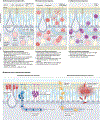Olfactory immunology: the missing piece in airway and CNS defence
- PMID: 38097777
- PMCID: PMC11560121
- DOI: 10.1038/s41577-023-00972-9
Olfactory immunology: the missing piece in airway and CNS defence
Abstract
The olfactory mucosa is a component of the nasal airway that mediates the sense of smell. Recent studies point to an important role for the olfactory mucosa as a barrier to both respiratory pathogens and to neuroinvasive pathogens that hijack the olfactory nerve and invade the CNS. In particular, the COVID-19 pandemic has demonstrated that the olfactory mucosa is an integral part of a heterogeneous nasal mucosal barrier critical to upper airway immunity. However, our insufficient knowledge of olfactory mucosal immunity hinders attempts to protect this tissue from infection and other diseases. This Review summarizes the state of olfactory immunology by highlighting the unique immunologically relevant anatomy of the olfactory mucosa, describing what is known of olfactory immune cells, and considering the impact of common infectious diseases and inflammatory disorders at this site. We will offer our perspective on the future of the field and the many unresolved questions pertaining to olfactory immunity.
© 2023. Springer Nature Limited.
Conflict of interest statement
Competing interests
The authors declare no competing interests.
Figures


Similar articles
-
Distinct olfactory mucosal macrophage populations mediate neuronal maintenance and pathogen defense.Mucosal Immunol. 2024 Oct;17(5):1102-1113. doi: 10.1016/j.mucimm.2024.07.009. Epub 2024 Jul 27. Mucosal Immunol. 2024. PMID: 39074615 Free PMC article.
-
Olfactory transmucosal SARS-CoV-2 invasion as a port of central nervous system entry in individuals with COVID-19.Nat Neurosci. 2021 Feb;24(2):168-175. doi: 10.1038/s41593-020-00758-5. Epub 2020 Nov 30. Nat Neurosci. 2021. PMID: 33257876
-
SARS-CoV-2: Olfaction, Brain Infection, and the Urgent Need for Clinical Samples Allowing Earlier Virus Detection.ACS Chem Neurosci. 2020 May 6;11(9):1200-1203. doi: 10.1021/acschemneuro.0c00172. Epub 2020 Apr 13. ACS Chem Neurosci. 2020. PMID: 32283006
-
Smell and taste disorders in COVID-19: From pathogenesis to clinical features and outcomes.Neurosci Lett. 2021 Mar 23;748:135694. doi: 10.1016/j.neulet.2021.135694. Epub 2021 Feb 15. Neurosci Lett. 2021. PMID: 33600902 Free PMC article. Review.
-
Pathophysiology of SARS-CoV-2 Infection of Nasal Respiratory and Olfactory Epithelia and Its Clinical Impact.Curr Allergy Asthma Rep. 2023 Feb;23(2):121-131. doi: 10.1007/s11882-022-01059-6. Epub 2023 Jan 4. Curr Allergy Asthma Rep. 2023. PMID: 36598732 Free PMC article. Review.
Cited by
-
Therapeutic glycan-specific antibody binding mediates protection during primary amoebic meningoencephalitis.Infect Immun. 2024 Oct 15;92(10):e0018324. doi: 10.1128/iai.00183-24. Epub 2024 Sep 5. Infect Immun. 2024. PMID: 39235225 Free PMC article.
-
Why do central nervous system barriers host a diverse immune landscape?Trends Immunol. 2024 Oct;45(10):738-749. doi: 10.1016/j.it.2024.08.009. Epub 2024 Sep 18. Trends Immunol. 2024. PMID: 39299888 Review.
-
Cryptococcus neoformans rapidly invades the murine brain by sequential breaching of airway and endothelial tissues barriers, followed by engulfment by microglia.mBio. 2024 Apr 10;15(4):e0307823. doi: 10.1128/mbio.03078-23. Epub 2024 Mar 21. mBio. 2024. PMID: 38511961 Free PMC article.
-
Distinct olfactory mucosal macrophage populations mediate neuronal maintenance and pathogen defense.Mucosal Immunol. 2024 Oct;17(5):1102-1113. doi: 10.1016/j.mucimm.2024.07.009. Epub 2024 Jul 27. Mucosal Immunol. 2024. PMID: 39074615 Free PMC article.
-
Regional specialization within the mammalian respiratory immune system.Trends Immunol. 2024 Nov;45(11):871-891. doi: 10.1016/j.it.2024.09.011. Epub 2024 Oct 21. Trends Immunol. 2024. PMID: 39438172 Review.
References
-
- Bergwerk M et al. Covid-19 breakthrough infections in vaccinated health care workers. N. Engl. J. Med 385, 1629–1630 (2021). - PubMed
Publication types
MeSH terms
Grants and funding
LinkOut - more resources
Full Text Sources
Medical

